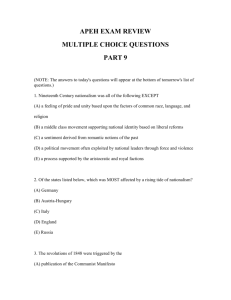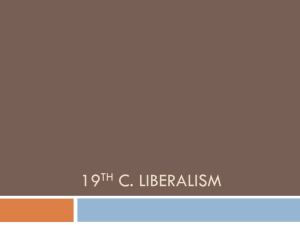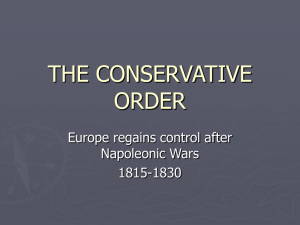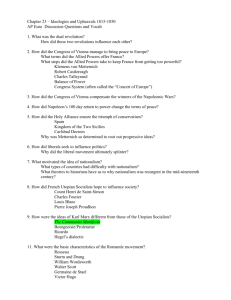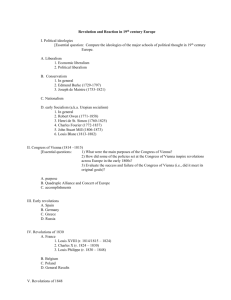The Revolutions of 1848
advertisement
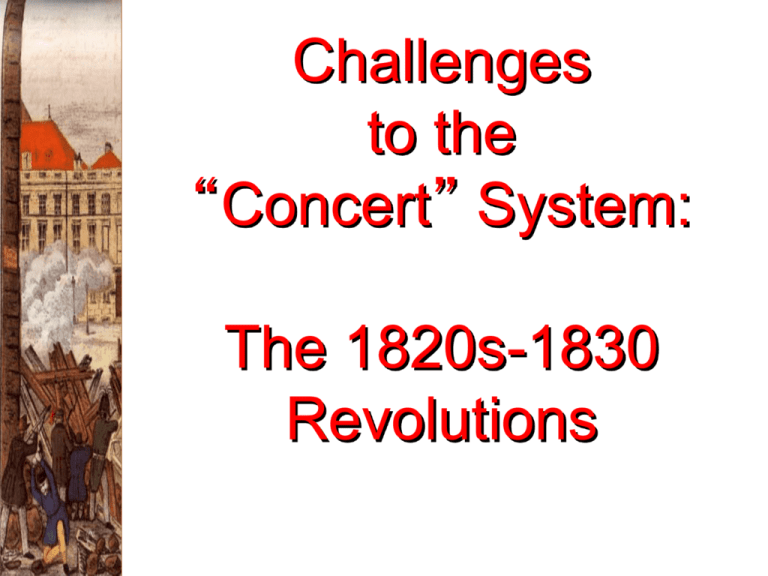
Challenges to the “Concert” System: The 1820s-1830 Revolutions c 19 Latin American Independence Movements Revolutionary Movements Independence Movements in the Balkans Greek Revolution – 1821 Greek Independence • The “Eastern Question” • Hetairia Philike a secret society that inspired an uprising against the Turks in 1821. • Pan-Hellenism • 1827 Battle of Navarino • Br, Fr, Rus destroyed the OttomanEgyptian fleet. • 1828 Rus declared war on the Otts. • 1829 Treaty of Adrianople • 1830 Greece declared an independent Greece on the Ruins of Missilonghi by Delacroix, 1827 nation [Treaty of London]. Lord Byron – Martyr in Greece The 1830 Revolutions Liberal Reform in Great Britain • Parliament manipulated by the king • Undemocratic • Aristocracy repressed every kind of popular protest • Corn Laws 1815 • Prohibited importation of foreign grain unless the price at home rose to improbable levels • Resulted in protests and demonstrations by urban laborers • 1817- Tory government responded by temporarily suspending traditional rights of peaceable assembly and habeas corpus Peterloo Massacre • 1819- Parliament passed the Six Acts • Controlled heavily taxed press and practically eliminated all mass meetings • Saint Peter’s Field- Manchester • Orderly protest • Broken up by armed cavalry • “Battle of Peterloo” Reform Bill of 1832 • New manufacturing and commercial groups demanded for more government representation • Liberal Reform• Reform of town government • Organization of new police force • More rights for Catholics and dissenters • Reform of the Poor Laws • Whig Party more responsive to commercial and manufacturing interests • Introduced “an act to amend the representation of the people of England and Wales” Reform Bill of 1832 • Reluctantly approved by the House of Lords • House of Commons emerged as the allimportant legislative body • New industrial areas gained representation • Eliminated “rotten boroughs” • Electoral districts with few voters and controlled by landed aristocracy • Number of voters increased by about 50% • Gave 12% of adult males right to vote Radical Reform • “People’s Charter”- Chartist Movement • Parliament rejected all petitions for universal suffrage • Anti-Corn Law League- Manchester 1839 • Repealed in 1846 • Ten Hours Act of 1847• Limited workday for women and young people in factories to 10 hours Ireland and the Great Famine • Irish peasantry (rented their land from a tiny minority of Church of England protestants) lived in poverty • Population rise • 3 million (1725), 4 million (1780), 8 million (1840) • Due to cultivation of the potato, early marriage, and exploitation of peasants by landlords • Potato crop failed in 1845, 1846, 1848, 1851 • British inaction (committed to laissez-faire) • 1 million emigrants fled famine between 18451841 • 1911- population of 4.4 million • Spurred Irish nationalism France: The “Restoration” Era • France emerged from the chaos of its revolutionary period as the most liberal large state in Europe. (1815-1830) • Louis XVIII governed France as a Constitutional monarch. • He agreed to observe the 1814 “Charter” or Constitution of the Restoration period. • • • • Limited royal power. Granted legislative power. Protected civil rights. Upheld the Napoleon Code. Louis XVIII (r. 1814-1824) The “Ultras” • France was divided by those who had accepted the ideals of the Fr. Revolution and those who didn’t. • The Count of Artois was the leader of the “Ultra-Royalists” • 1815 “White Terror” • Royalist mobs killed 1000s of former revolutionaries. • 1816 elections The Count of Artois, the future King Charles X (r. 1824-1830) • The Ultras were rejected in the Chamber of Deputies election in favor of a moderate royalist majority dependent on middle class support. France: Conservative Backlash • 1820the Duke of Berri, son of Artois, was murdered. • Royalists blamed the left. • Louis XVIII moved the govt. more to the right • Changes in electoral laws narrowed the eligible voters. • Censorship was imposed. • Liberals were driven out of legal political life and into illegal activities. • 1823 triumph of reactionary forces! • Fr troops were authorized by the Concert of Europe to crush the Spanish Revolution and restore another Bourbon ruler, Ferdinand VII, to the throne there. King Charles X of France • His Goals: (r. 1824-1830) • Lessen the influence of the middle class. • Limit the right to vote. • Put the clergy back in charge of education. • Public money used to pay nobles for the loss of their lands during the Fr Revolution. King Charles X of France • His Program: (r. 1824-1830) • Attack the 1814 Charter. • Control the press. • Dismiss the Chamber of Deputies when it turned against him. • Appointed an ultra-reactionary as his first minister. • 1830 Election brought in another liberal majority. • July Ordinances • He dissolved the entire parliament. • Strict censorship imposed. • Changed the voting laws so that the government in the future could be assured of a conservative victory. To the Barracades Revolution, Again!! Workers, students and some of the middle class call for a Republic! Victor Hugo’s Les Miserables Published in 1862 Plot from 1815- June Rebellion of 1832 http://www.youtube.com/watch?v=2 BlWAImZevs Louis Philippe The “Citizen King” • • The Duke of Orleans. • • Lead a thoroughly bourgeois life. Relative of the Bourbons, but had stayed clear of the Ultras. His Program: • Property qualifications reduced enough to double eligible voters. • Press censorship abolished. • The King ruled by the will of the people, not by the will of God. • The Fr Revolution’s tricolor replaced the Bourbon flag. • The government was now under the control of the wealthy middle class. (r. 1830-1848) Louis Philippe The “Citizen King” • His government ignored the needs and demands of the workers in the cities. • They were seen as another nuisance and source of possible disorder. • July, 1832 an uprising in Paris was put down by force and 800 were killed or wounded. • 1834 Silk workers strike in Lyon was crushed. • Seething underclass. • Was seen as a violation of the status quo set down at the Congress of Vienna. A caricature of Louis Philippe Rue Transnonian- 1834 Honoré Daumier Belgian Independence, 1830 • The first to follow the lead of France. • Its union with Holland after the Congress of Vienna had not proved successful. • There had been very little popular agitation for Belgian nationalism before 1830 seldom had nationalism arisen so suddenly. • Wide cultural differences: • North Dutch Protestant seafarers and traders. • South French Catholic farmers and individual workers. Belgian Revolution - 1830 A Stirring of Polish Nationalism - 1830 A Stirring of Polish Nationalism - 1830 • The bloodiest struggle of the 1830 revolutions. • The Poles in and around Warsaw gain a special status by the Congress of Vienna within the Russian Empire. • Their own constitution. • Local autonomy granted in 1818. • After Tsar Alexander I dies, the Poles became restless under the tyrannical rule of Tsar Nicholas I. A Stirring of Polish Nationalism - 1830 • Polish intellectuals were deeply influenced by Romanticism. • Rumors reached Poland that Nicholas I was planning to use Polish troops to put down the revolutions in France and Belgium. • Several Polish secret societies rebelled. A Stirring of Polish Nationalism - 1830 • Had the Poles been united, this revolt might have been successful. • But, the revolutionaries were split into moderates and radicals. • The Poles had hoped that Fr & Eng would come to their aid, but they didn’t. A Stirring of Polish Nationalism - 1830 • Even so, it took the Russian army a year to suppress this rebellion. • The irony by drawing the Russian army to Warsaw for almost a year, the Poles may well have kept Nicholas I from answering Holland’s call for help in suppressing the Belgian Revolt. Europe in 1830 The Results of the 1820s-1830 Revolutions? 1. The Concert of Europe provided for a recovery of Europe after the long years of Revolution and Napoleonic Wars. 2. The conservatives did NOT reverse ALL of the reforms put in place by the French Revolution. 3. Liberalism would challenge the conservative plan for European peace and law and order. The Results of the 1820s-1830 Revolutions? 4. These revolutions were successful only in W. Europe: • Their success was in their popular support. • Middle class lead, aided by the urban lower classes. 5. The successful revolutions had benefited the middle class the workers, who had done so much of the rioting and fighting, were left with empty hands! 6. Therefore, these revolutions left much unfinished & a seething, unsatisfied working class. The Revolutions Of 1848 “The Springtime of Peoples” Pre-1848 Tensions: Long-Term • Industrialization • Economic challenges to rulers. • Rapid urbanization. • Challenges to the artisan class. • Population doubled in the 18c • Food supply problems Malthus • Ideological Challenges • Liberalism, nationalism, democracy, socialism. • Romanticism • Repressive Measures • Carlsbad Decrees [Prus.] • Six Acts [Eng.] • Secret police created in many European states. Pre-1848 Tensions: Short-Term • Agricultural Crises • Poor cereal harvests • prices rose 60% in one year. • Potato blight Ireland • Prices rose 135% for food in one year! • Financial Crises • Investment bubbles burst railways, iron, coal. • Unemployment increased rapidly [esp. among the artisan class]. Working & middle classes are now joined in misery as are the urban and agricultural peasantry! Prince Metternich 1815: We have redrawn Europe’s map for eternity. Not Really: Centers of Revolution in 1848 No Coherent Organized Revolutions • Many different reasons for revolutionary activities. • Reactions to long- and short-term causes. • Competing ideologies in different countries. • Different revolutionary leaders, aims, and goals in different countries. • Some countries had no revolutions: • England. • Russia. FRANCE: The Giant Sea Snake? FRANCE Louis Philippe, “The Pear,” 1848 Prince Louis: Not Too Steady! Victor Hugo & Miguel de Girardin try to raise Prince Louis upon a shield. [Honoré Damier’s lithograph published in Charavari, December 11, 1848]. The February Revolution • Working class & liberals unhappy with King Louis Philippe, esp. with his minister, Francois Guizot [who opposed electoral reform]. • Reform Banquets used to protest against the King. • • • • Paris Banquet banned. Troops open fire on peaceful protestors. Barricades erected; looting. National Guard [politically disenfranchised] defects to the radicals. • King Louis Philippe loses control of Paris and abdicates on February 24. Alphonse Lamartine • A poet & liberal, he believed in the “Rights of Man.” • To vote, to free speech, to property, & to a secular education. • Declared a new Provisional Government. • Conservatives & liberals are suspicious of republicanism • Reminiscent of the Reign of Terror. Louis Blanc • A Social Democrat. • He believed in the “Right to Work.” • National Workshops. • Provide work for the unemployed. • Financial Crisis • Flight of capital. • Stock market crashes [55% decline]. • New 45% increase of taxes on the peasants. The Coalition Splits: Mar.-May • The conflicts between liberals & socialists over: • The timing of elections to the Constituent Assembly. • The costs of government social programs. • Did they violate laissez-faire? • The question of whether you could have liberty for all men and still have a system based on private property. • Growing social tensions between the working class & the bourgeois middle class regarding: • The nature of work. • The right to unionize. • Pay levels. April Elections • Resulted in a conservative majority in the National Assembly. • They began debating the fate of social programs [like the National Workshops]. • The conservative majority wanted the removal of radicals like Blanc from the government. • In early June, the National Workshops were shut down. • This heightened class tensions! The “June Days” • Worker groups in Paris rose up in insurrection. • They said that the government had betrayed the revolution. • Workers wanted a redistribution of wealth. • Barricades in the streets. • A new liberal-conservative coalition formed to oppose this lower class radicalism. Paris: To the Barricades Again! The 2nd French Republic (1848-1852) • General Louis Cavaignac assumed dictatorial powers & crushed the revolt. • 10,000 dead. • A victory for conservatives. The Republic by Jean-Leon Gerome • Nov., 1848 a new constitution provided for: • An elected President. • A one-house legislature. President Louis Napoleon • The December election: • The “law and order” candidate, Louis Napoleon Bonaparte, defeated Cavaignac. • This was a big shift in middle class opinion to the right! • The New President: • Purged the govt. of all radical officials. • Replaced them with ultra-conservative and monarchists. • Disbanded the National Assembly and held new elections. • Represented himself as a “Man of the People.” • His government regularly used forced against dissenters. 1851 Coup d’Etat • President Louis Napoleon declared a hereditary 2nd French Empire. • A national plebiscite confirmed this. The HAPSBURG EMPIRE The Austrian Empire: 1830 Ferdinand I (1793-1875) • The nature of the Austrian Empire: • Very conservative monarchy [liberal institutions didn’t exist]. • Culturally and racially heterogeneous. • Social reliance on serfdom dooms masses of people to a life without hope. • Corrupt and inefficient. • Competition with an increasingly powerful Prussia. Therefore, the Empire was vulnerable to revolutionary challenges. Austrian Students Form a Militia Vienna, 1848: The Liberal Revolution • The “February Revolution” in France triggered a rebellion for liberal reforms. • March 13 rioting broke out in Vienna. • The Austrian Empire collapsed. • Metternich fled. • Constituent Assembly met. • Serfdom [robot] abolished. • The revolution began to wane. • The revolutionary government failed to govern effectively. The New Austrian Emperor Franz Joseph I [r. 1848-1916] The Hungarian Revolution Lajos Kossuth (1802-1894) • Hungarian revolutionary leader. • March laws provided for Hungarian independence. • Austrians invade. • Hungarian armies drove within sight of Vienna! • Slavic minorities resisted Magyar invasion & the Hungarian army withdrew. • Austrian & Russian armies defeated the Hungarian army. • Hungary would have to wait until 1866 for autonomy. Tsar Nicholas I (r. 1825-1855) • He raised an army of 400,000 in response to a request from Franz Joseph. • 140,000 put down the Hungarian revolt. The German States Germania - 1848 Frederick William IV of Prussia (1840-1861) • Mad as a hatter! • Anti-liberal, but an ‘Arthurian’ medieval romantic. • Agricultural romantic. • Relied on Junker support. • Prussia in the mid-19c: • Efficient. • Good economy. • Strong military. The Germans Follow the French • After the February French revolutions, there were many riots in minor German states. • Austria and Prussia expected to intervene to crush these revolts, BUT: • Vienna Revolution led to the fall of Metternich. • Berlin riots • Prussian army efficiently suppressed the revolutionaries. • King Frederick William IV withdraws the troops and hand the Prussia liberals a big victory! • Other Princedoms collapse when Prussia’s nerve fails. Funeral for Berlin Freedom Fighters The Frankfurt Assembly • German liberals are overjoyed! • German National Assembly established in Frankfurt: • Universal suffrage. • Delegates mostly from the middle class. • Debate over the nature of the state monarchy of Habsburgs or Hohenzollerns? • They chose the Austrian Habsburg Archduke John rather than the King of Prussia. • He was a well-known liberal sympathizer. • But they couldn’t guarantee the loyalty of the Prussian Army. Frankfurt Assembly Meets A Citizen Militia on Parade in Berlin The “Three Germanies” Prussian Resurgence • The Prussian army moved to crush the new Polish Grand Duchy. • The Prussian parliament disagreed with the Frankfurt Parliament. • The Prussian army invaded Schleswig-Holstein (at Frankfurt’s request). • Horrified international liberal opinion. • Britain & Russia threatened war with Prussia. • Prussia agreed to its own peace with Denmark. • The Prussian army abandoned the Frankfurt government. Austria & Prussia Reassert Control • Austria re-gained control of Vienna. • Frederick William deposed the Berlin parliament. • The Frankfurt Assembly offered the emperorship to Frederick William. • He declined. • Radicals took to the barricades again. • The Prussian army crushed all resistance. • April, 1849 the Assembly collapsed. A New German Confederation • Frederick William IV of Prussia was still interested in ruling a united Germany. • 1850 the German Confederation was re-established at Olmutz. • But, Frederick was forced to accept Austrian leadership of Central Europe. Liberalism Discredited in Germany • Little popular support. • The union of liberals and democrats didn’t last. • Rule of force was the only winner! • There was a massive exodus of liberal intelligentsia. • Militarism, hierarchy, and statism were triumphant! • Capitalists followed suit. THE AFTERMATH Democrats Swept Out of Europe Why did the 1848 Revolutions Fail? • They failed to attract popular support from the working classes. • The middle classes led these revolutions, but as they turned radical, the middle class held back. • Nationalism divided more than united. • Where revolutions were successful, the Old Guard was left in place and they turned against the revolutionaries. • Some gains lasted [abolition of serfdom, etc.] • BUT, in the long term, most liberal gains would be solidified by the end of the 19c: • The unification of Germany and Italy. • The collapse of the Hapsburg Empire at the end of World War I. The Bottom Line • It looked like the Conservative forces had triumphed. • BUT… • Things had changed forever. • Economic/social problems continued to be constant challenges to the ruling order. • Conservatives would have to make concessions in order to stay in power. • Many of the limited Liberal achievements remained permanent.

